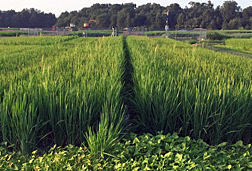This page has been archived and is being provided for reference purposes only. The page is no longer being updated, and therefore, links on the page may be invalid.
| Read the magazine story to find out more. |
|
|
Using Weedy Rice Traits to Boost Cultivated Rice Yields
By Sharon Durham
December 10, 2014
Genetic traits in weedy rice may someday be used to develop sturdy, high-yield varieties of cultivated rice that will flourish in the face of climate change, thanks to findings by scientists at the U.S. Department of Agriculture (USDA). This work, conducted by Agricultural Research Service (ARS) plant physiologist Lewis Ziska and his colleagues.
Ziska, who is with ARS's Crop Systems and Global Change Laboratory in Beltsville, Maryland, studied several rice cultivars to determine if changes in temperature and CO2 levels affected seed yields. He also looked for visible traits that could signal whether a plant cultivar has the genetic potential for adapting successfully to elevated CO2 levels.
The investigation included weedy red rice, which infests cultivated rice cropland. Despite the plant's downsides, previous assessments indicated that weedy rice growing under elevated CO2 levels had higher seed yields than cultivated rice growing under the same conditions.
Ziska monitored the different rice cultivars at current and future projections of atmospheric CO2 and a range of day/night air temperatures. He observed that on average, all the rice cultivars put out more aboveground biomass at elevated CO2 levels, although this response diminished as air temperatures rose.
For seed yield, only weedy rice and the rice cultivar 'Rondo' responded to elevated CO2 levels when grown at optimal day/night air temperatures of 84 °F and 70 °F. In addition, only the weedy rice gained significant increases of aboveground biomass and seed yield under elevated CO2 levels at the higher temperatures expected for rice-growing regions by 2050.
Seed yield is a trait linked to seed head and tiller production. Tillers are stalks put out by a growing rice plant. As the plant matures, the seed heads-where rice grain is produced-develop at the end of the tillers. This suggests that crop breeders might someday be able to use this weedy rice trait to develop commercial rice cultivars that can convert rising CO2 levels into higher seed yields.
These findings were published in Functional Plant Biology in 2013. This work supports the USDA priority of responding to climate change. ARS is USDA's chief intramural scientific research agency.
Read more about this work in the November/December 2014 issue of Agricultural Research magazine.

